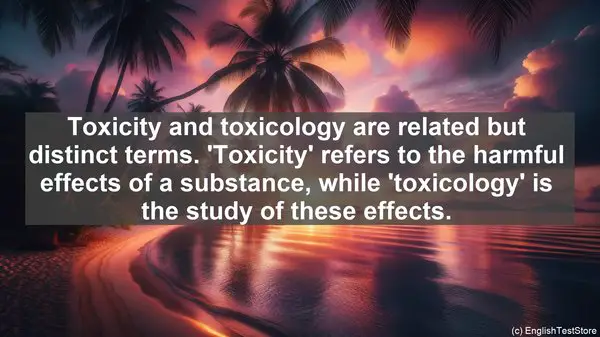Introduction
Welcome to today’s lesson on the top 10 commonly confused words in pharmaceutical toxicology. As you delve into the world of pharmaceutical sciences, you’ll encounter numerous technical terms. However, some words may seem similar but have distinct meanings. Understanding these differences is crucial to avoid any misinterpretations or errors in your future work. So, let’s get started!

1. Dose vs. Dosage
The terms ‘dose’ and ‘dosage’ are often used interchangeably, but they have different implications. ‘Dose’ refers to the amount of a substance administered at a given time, while ‘dosage’ encompasses the frequency and duration of the administration. For example, a medication may have a recommended dose of 50mg, but the dosage could be ‘twice daily for a week.’ So, while the dose is the quantity, the dosage is the complete regimen.

2. Toxicity vs. Toxicology
Toxicity and toxicology are related but distinct terms. ‘Toxicity’ refers to the harmful effects of a substance, while ‘toxicology’ is the study of these effects. In other words, toxicity is the outcome, and toxicology is the field that investigates it. Toxicologists analyze the mechanisms, doses, and routes of exposure to understand the impact of substances on living organisms.
3. Adverse Effect vs. Side Effect
When we talk about the undesired outcomes of a medication, we often use the terms ‘adverse effect’ and ‘side effect.’ While they both refer to negative consequences, there’s a subtle difference. An ‘adverse effect’ is a broader term, encompassing any undesirable reaction, whether expected or unexpected. On the other hand, a ‘side effect’ specifically refers to an unintended reaction that occurs at therapeutic doses. So, all side effects are adverse effects, but not all adverse effects are side effects.
4. Efficacy vs. Effectiveness
In assessing the performance of a medication, we consider both ‘efficacy’ and ‘effectiveness.’ ‘Efficacy’ refers to how well a drug works under ideal conditions, such as in controlled clinical trials. It’s a measure of the drug’s potential. ‘Effectiveness,’ on the other hand, takes into account real-world scenarios, including factors like patient adherence and co-existing conditions. It reflects how well the drug performs in routine clinical practice.
5. Pharmacokinetics vs. Pharmacodynamics
When studying a drug’s actions, we encounter the terms ‘pharmacokinetics’ and ‘pharmacodynamics.’ ‘Pharmacokinetics’ deals with how the body affects the drug, encompassing processes like absorption, distribution, metabolism, and excretion. On the other hand, ‘pharmacodynamics’ focuses on how the drug affects the body, including its mechanisms of action and therapeutic effects. So, while pharmacokinetics is about what the body does to the drug, pharmacodynamics is about what the drug does to the body.
6. Contraindication vs. Precaution
In medical practice, we often come across terms like ‘contraindication’ and ‘precaution’ when considering the use of a medication. A ‘contraindication’ is a situation or condition where the use of a drug is absolutely not recommended, as it may cause harm or worsen the condition. On the other hand, a ‘precaution’ is a circumstance where the drug can still be used, but with careful monitoring or certain adjustments. So, while contraindications are absolute, precautions require careful consideration.
7. Generic vs. Brand Name
When it comes to medications, you’ll often encounter the terms ‘generic’ and ‘brand name.’ A ‘generic’ drug is a medication that contains the same active ingredient as a brand-name drug. It’s usually more affordable and undergoes rigorous testing to ensure its safety and efficacy. On the other hand, a ‘brand-name’ drug is the original product, often introduced by a pharmaceutical company. While the active ingredient is the same, there may be differences in formulation or non-active components. Brand-name drugs are usually more expensive due to research and marketing costs.
8. Over-the-Counter vs. Prescription
When you visit a pharmacy, you’ll notice that some medications are ‘over-the-counter’ (OTC), while others require a ‘prescription.’ The distinction lies in their accessibility. OTC drugs can be purchased without a prescription, as they’re considered safe and effective for self-use. However, prescription drugs require a healthcare professional’s authorization, as they may have higher risks or need specific monitoring. This differentiation ensures that certain medications are used appropriately and under professional guidance.
9. Tolerance vs. Dependence
When discussing the long-term use of certain medications, the terms ‘tolerance’ and ‘dependence’ often arise. ‘Tolerance’ refers to the body’s reduced response to a drug over time, necessitating higher doses to achieve the same effect. On the other hand, ‘dependence’ is a state where the body becomes reliant on the drug to function normally. Dependence can be physical, leading to withdrawal symptoms upon discontinuation, or psychological, with a strong desire to continue using the drug. Tolerance can be a factor in the development of dependence, but they’re not synonymous.
10. Placebo vs. Nocebo
In clinical research and practice, placebos play a significant role. A ‘placebo’ is an inactive substance, like a sugar pill, that has no therapeutic effect. It’s often used in controlled trials to compare the effects of a new drug with no treatment. On the other hand, a ‘nocebo’ is a phenomenon where a patient experiences negative effects, such as side effects, even though they’re receiving an inactive substance. This highlights the power of the mind and the influence of expectations on health outcomes.
